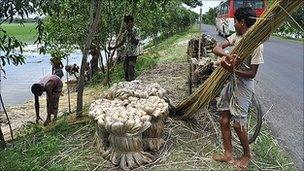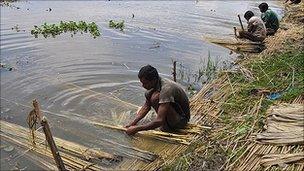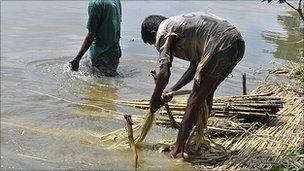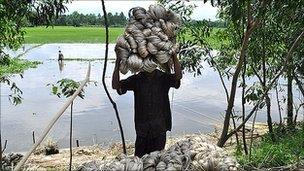Bangladesh's 'golden fibre' comes back from the brink
- Published
WATCH: Jute has been processed in the same way for generations
Jute, a vegetable fibre that can be spun into sackcloth, used to be the 'golden fibre' of Bangladesh.
It brought much-needed foreign income to the impoverished nation.
But it lost its lustre in the 1980s after synthetic materials like polythene and plastics were introduced.
Now the natural fibre has made a spectacular comeback.
Exports of jute and jute products from Bangladesh this fiscal year crossed a record billion dollars as demand for the natural fibre is steadily increasing.

Jute is grown all over Bangladesh
With growing environmental awareness, jute, which is bio-degradable, has become the preferred alternative to polluting synthetic bags.
Jute is considered to be the second most important natural fibre after cotton in terms of cultivation and usage. It is mainly grown in eastern India, Bangladesh, China and Burma.
Until recently the fibre was used mostly as a packaging material. With a diversification of jute products, the demand for jute has increased.
"By processing the fibre mechanically and by treating it chemically, now jute can be used to make bags, carpets, textiles and even as insulation material," says Mohammad Asaduzzaman, a scientist at the Bangladesh Jute Research Institute in Dhaka.

After harvesting, the jute is stored in water until it begins to rot
When synthetics like polythene bags came into widespread use, the demand for jute declined and many jute mills in countries like Bangladesh were shut down.
Thousands lost their jobs and farmers shifted from jute to more profitable rice cultivation.
Today, as demand increases, more farmers are returning to this traditional crop.
It is estimated that nearly five million farmers are involved in jute plant cultivation in Bangladesh. It plays a key supportive role to the rural economy of Bangladesh.
Once the jute plants are harvested they are bundled together and immersed in running water and allowed to rot.

One it has become soft, the jute fibre is separated by hand
Then the fibres are stripped from the plant. The stripped fibre is dried and later sent to mills for processing.
Golam Moazzam, a research fellow at the Centre for Policy Dialogue, in Dhaka says: "It is important to note that policy support also contributed to its widespread use of jute both locally and internationally.
"For example, the Bangladeshi government has made it compulsory to use jute bags for packaging of food grains."
New uses
Jute is also versatile, strong and long-lasting and scientists say they are discovering more uses for it in different sectors.
For example, Geotextiles, a diversified jute product, is used for soil-erosion control and also used in laying roads to give more durability. The natural fibre is also used to make pulp and paper.

Once dry, the jute fibres are bundled and sent to factories to be processed
Bangladeshi scientists are now working on an ambitious project to blend jute fabric with cotton to produce denim fabric.
They say if the jute plant is harvested earlier than the usual period of 120 days, then it gives a softer fabric.
"If this special quality of fibre is chemically modified and bleached then it becomes softer. If we can blend it with cotton then we can manufacture denim fabric and diversified textile products," says Mr Asaduzzaman
If this process can be commercialised, he says, it will bring down the demand for cotton, which is also becoming dearer day by day.
The price of fabric can be reduced by a half, bringing benefits to the country's garment sector.

The resurgence of the jute industry has created jobs for many local people
However, there are bottlenecks.
Special machines are required to blend this fibre with cotton and they are yet to be produced commercially. Scientists hope spinning factories will be able to install these machines in the near future.
"Unfortunately, there is not much research going on in terms promoting diversified jute products," says Mr Moazzam.
"Countries like Bangladesh and India, who are the major jute exporting countries, should conduct collaborative research to find out diversification of jute products."